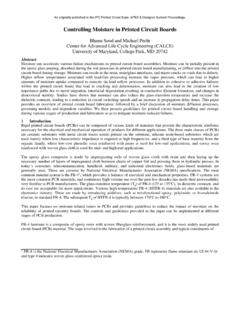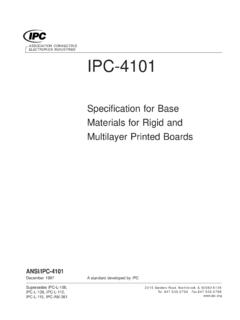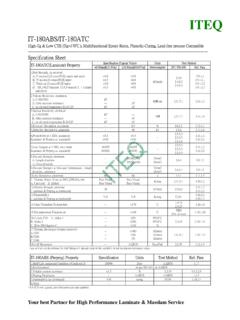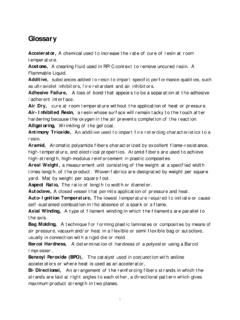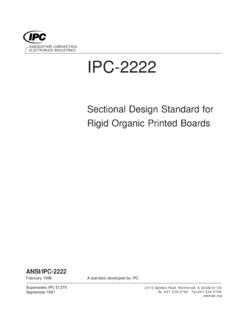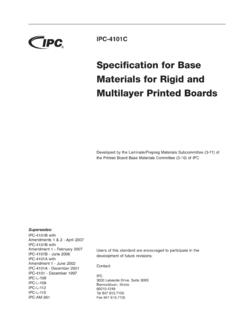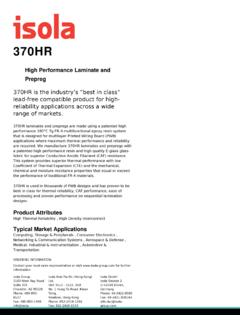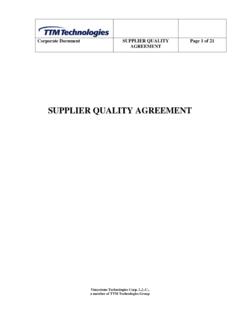Transcription of PRODUCT DEVELOPMENT FOR OUT- OF …
1 PRODUCT DEVELOPMENT FOR OUT- OF-AUTOCLAVE (OOA). MANUFACTURE OF AEROSPACE. STRUCTURES. Steve Mortimer, Matthew J. Smith Hexcel Duxford, Cambridgeshire, UK. Elizabeth Olk Hexcel Dublin, California, USA. Overview Why use the OOA process ? Benchmarking of Existing Products Matrices Fabric styles DEVELOPMENT of an OOA prepreg (M56). Requirements Processing Performance Demonstrator parts Next Generation Developments Summary 1. Why Out of Autoclave? Significant increase expected in composites used in aircraft manufacture over the coming years Boeing 787. Airbus A350. Autoclave capacity Ovens are lower capital investment The cost benefit to the customer ? Materials and processes are the same Reduced tooling costs Lower temperature cure Reliable inspection Modern ultrasonic inspection methods can assure part quality 2. OOA DEVELOPMENT PRODUCT Requirements Acceptable Porosity Levels Secondary structure < 2%. Primary structure - < % ? Cure ply thickness Similar to Autoclave Mechanical performance Same as equivalent autoclave prepregs Processing Good tack / handling Similar lay-up / bagging to standard prepregs Must be capable for automated process (ATL/AFP).
2 PRODUCT format UD (134 268 gsm), woven (193PW-), RFI. 3. M56 PRODUCT DEVELOPMENT PRODUCT Resin Reinforcement Process Bagging Cure cycle Performance 4. M56: PRODUCT Forms UD carbon tape: M56/35%/UD134/AS7-12K M56/35%/UD268/IMA-12K. M56/35%/UD268/AS7-12K M56/35%/UD268/IM7-12K. PRODUCT forms can be tailored to suit ATL / AFP presentation Woven Fabric M56/40%/280H5/AS4-3K. M56/40%/193PW/AS4-3K. Woven glass: M56/37%/7581 (8 HS weave). M56/37%/120 (4 HS weave). Bronze mesh - M56/38%/BZ80 (80gsm Bronze mesh). 5. Fibre Volume Vs PRODUCT Type Products optimised to achieve comparable fibre volume to autoclave cure 6. M56 Processing: Bagging Vacuum port Vacuum bag Breather fabric Non-porous release film Porous release film Peel ply Laminate Peel ply PTFE coated glass or released tool Optimum OOA bagging surface breathing to remove air 7. M56 Processing: Cure Cycles Temperature Temperature 120min 120min 180 C. 180 C. 1 C/min 1 C/min 60min 60min 110 C. 110 C. 1 C/min 1 C/min Time Time Vacuum Vacuum Sandwich structure Monolithic structure Vacuum cycle adapted to part type Lower temperature 6 hours at 135 C cycle possible 8.
3 M56 Processing: Typical OOA UD Laminate Quality M56/35%/UD268/IMA-12K. Typical porosity < 9. M56 - 80 Ply UD Laminate (20 mm Thickness). Thick laminates possible with low porosity 10. Mechanical Performance M56 mechanical data compared with 8552 autoclave prepreg UD prepreg, 35% resin content, 145 FAW IM7 fibre. Wet Tg 120. 100. CAI 80 0 Comp Strength 60. 40. 20. 8552. 0. M56. OHT OHC. ILSS IPSS. Large mechanical database developed. Compares well with 8552 but a little lower in compression. 11. Demonstrator Parts Challenges Low porosity Complex geometry Thin skin over core Surface finish Automated processes - ATL. - AFP. Trials have covered several critical processes 12. Demonstrator Parts -A320 Fillet Fairing Materials M56/40%/280H5/AS4-3K. 30mm HRH10 core Feedback Complex shape Fully passed water leak test (3 ply skin). Minimal spring back Photo: courtesy of GE Aviation UK. Sealing of core with good finish particularly effective over complex shape. 13. Demonstrator parts Surface finish Materials: M56/40%/193PW/AS4-3K.
4 HRH10 25 mm core Laminado Laminado Laminado com colm ia Tool surface s lido s lido e surface film Peel ply Surface film Excellent surface finish without need for surfacing films allowing direct painting 14. Automated processing M56 UD tapes have successfully been used in ATL and AFP. trials with several component manufacturers. Fullyimpregnated material is essential for success in automated processes. Surface breathing results in low porosity parts 268g FAW UD tapes successfully processed Photo courtesy of GKN UK. 15. M56/35%/UD268/AS7-12K. Photo 16. courtesy of GKN UK. Conclusions HexPly M56 was specifically designed for out-of-autoclave processing Available with a variety of reinforcements Fully impregnated for ATL / AFP processing Handle as for autoclave' prepregs BUT cure under vacuum in an oven Suitable for aerospace quality sandwich panels and monolithic laminates Several demonstrator parts successfully manufactured M56 material in qualification Next generation products under DEVELOPMENT OOA processing can produce high quality parts and is gaining acceptance in aerospace 17.

